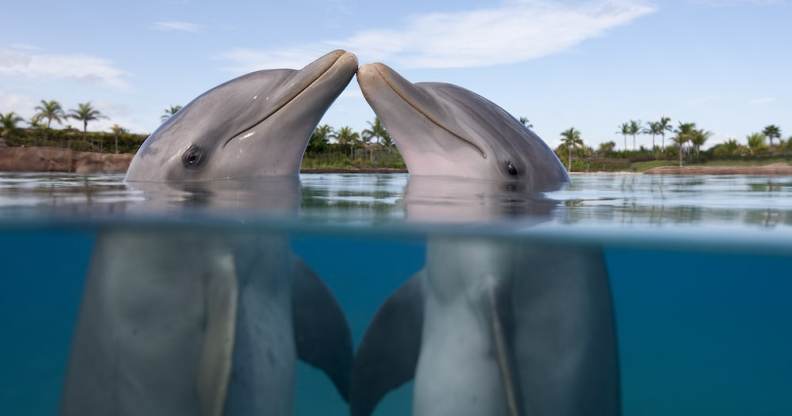Dolphins have functional clitorises they use in lesbian sex, according to science

Bottlenose dolphins. (Getty/ Stephen Frink)
Scientists have discovered that dolphins have clitorises “similar to humans”, which they make use of in creative lesbian sex.
A new study published in the journal Current Biology has found that dolphins, who often have sex to maintain social bonds as well as for reproduction, have clitorises that are evolved for pleasure.
Researchers analysed the genitals of 11 female bottlenose dolphins that had died of natural causes and found that their clitorises had erectile tissue structures, lots of blood vessels, large nerves and nerve endings just under the skin.
These similarities to the human clitoris led scientists to conclude that the dolphins feel pleasure during sex, which would explain why they have so much of it.
Biologist and lead researcher Patricia Brennan told the New Scientist: “Bottlenose dolphins live close to the shore, where scientists can go out on their boats and study them.
“They see them having sex year-round, even when the females are not receptive, so not ready to get pregnant and have babies.
“And not only do they have sex all the time, they have a lot of homosexual sex as well.”
Dolphins get creative with lesbian sex, Brennan explained: “The females will rub each other’s clitorises with their snouts and their flippers really often.
“It’s not like every once in a blue moon you’ll see females stimulating each other, it’s actually pretty common. Females also masturbate.
“If they’re out there seeking all these sexual experiences, it’s likely that it’s probably feeling good.”
A study shows female dolphins have a fully functional clitoris.
This study was a shock to everyone but lesbian dolphins.
— Alex Kaseberg (@AlexKaseberg) January 10, 2022
https://twitter.com/IlllllllllllllI/status/1480599273243054081
Bottlenose dolphins' bottle noses are very useful for lesbian dolphin sex. Females will sometimes have sex with each other using their snouts as a dildo.— Vagina Museum (@vagina_museum) January 9, 2022
But studying dolphin genitals is also important in learning more about human sexuality and pleasure.
Brennan described the lack of research in animal sexuality as “baffling”, but the human clitoris was not even fully understood by scientists until the 1990s.
Speaking to AFP, she said that studying sex and pleasure in mammals could provide insights into human pleasure.
“There are certainly plenty of females who have problems during sex, for example, related to arousal, or related to pain during sex or inability to orgasm,” said Brennan.
“There are people who are uncomfortable with studies of sexual behaviour in general, whether in humans or other animals,” she told the New Scientist. “That doesn’t mean that sex is unimportant or that we shouldn’t be studying it.”

